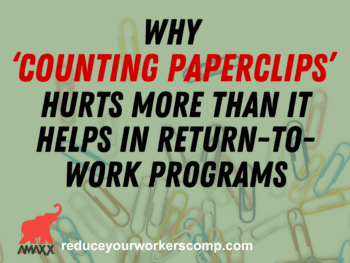RETURN TO WORK – ONTARIO, CANADA
Attorney David Brady with the Toronto law firm HicksMorley offers the following for employers with operations in Ontario, Canada. Many US-based employers believe that the Canadian workers’ comp laws are totally different than in the U.S. but that’s not the case. Many aspects of the system are similar, including returning injured employees to work as soon as they are medically able to do so. Each province’s laws vary, just like in the U.S. each state’s laws vary. This advise is specific to Ontario.
Attorney Brady advises employers to:
- Have a modified work policywhich assists injured workers to return to work to perform the essential duties of their own jobs, or if that is not medically appropriate, to perform the essential duties of another job that is suitable and available.
- Ensure that the injuredworker’s health care professionals are given a copy of the modified work policy as soon as reasonably possible.
- Seek functional abilitiesmedical information, with employee consent, from the injured worker’s health care professionals as soon as reasonably possible. The health care professionals should be provided with a job description and a physical demands analysis for the work offered.
- Explain to the injured worker the injured worker’s duty to co-operate with the employer respecting access to necessary medical information and the identification of jobs that may be medically suitable if the worker cannot reasonably be expected to return to his/her own job.
- Explain to the injured workerthe consequences of not co-operating in the return to work effort. Workers’ compensation benefits may be reduced or eliminated.
- On good medical and workplaceinformation, offer the injured worker a return to work plan consistent with the worker’s functional abilities. The return to work plan should be in writing.
- Copy all return to work correspondenceand documents to all concerned including the injured worker’s health care professional(s), the Workplace Safety and Insurance Board (WSIB) case manager, the injured worker, and the injured worker’s union representative if the injured worker has authorized the union representative to act on his or her behalf. Care should be taken not to communicate the worker’s medical information except as authorized.
- If necessary, involve a return to workWSIB mediator to resolve return to work barriers. This may result in an agreed-to Return To Work Plan signed by the workplace parties.
- Communicate with the WSIBcase manager during the return to work effort to enable the WSIB case manager to make evidence-based decisions about the worker’s benefit entitlement.
- Ensure the injured worker’s immediatesupervisor(s) and the worker clearly understand what is expected of the worker consistent with the worker’s functional abilities and the return to work plan.
Our advice takes into account Ontario’s Human Rights Code and the Workplace Safety and Insurance Act.
Many thanks to Attorney David W. Brady, Hicks Morley Hamilton Stewart Storie, LLP, Toronto, ON. Attorney Brady can be reached at 416-864-7310 or david-brady@hicksmorley.com www.hicksmorley.com
© Copyright 2009 Hicks Morley Hamilton Stewart Storie LLP
WC Calculator www.ReduceYourWorkersComp.com/calculator.php
TD Calculator www.ReduceYourWorkersComp.com/transitional-duty-cost-calculator.php
WC 101 www.ReduceYourWorkersComp.com/workers_comp.php
Do not use this information without independent verification. All state laws are different. Consult with your corporate legal counsel or other professionals before implementing any cost containment programs.
©2008 Amaxx Risk Solutions, Inc. All rights reserved under International Copyright Law. If you would like permission to reprint this material, contact Info@WorkersCompKit.com
















